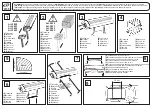
Accel calibrations used during the flight
Pad altitude ASL
After the first few minutes of flight, the data recording changes to a lower rate, and stores
approximately 35 minutes more. The liftoff mode will continue, and deployment outputs
will function if necessary, after the end of the data recording. The liftoff mode only ends
when landing is detected.
When the flight conditions assigned for each output are true,
(See configuring the Raven
using the FIP section)
the output switch will turn on. The default deployment conditions
are the following:
Output function
Apogee
deployment
Main chute
deployment
Backup apogee
deployment
Backup Main
deployment
Altimeter output
Label
Apo
Main
3
rd
4th
Upward velocity
(from accel)
< 400 ft/sec
< 400 ft/sec
< 0 ft/sec
< 400 ft/sec
Baro altitude
Decreasing
Decreasing
Increasing or
decreasing
Decreasing
Altitude above pad
Any
< 700 feet
Any
< 700 feet
Time delay
0
0
2 sec
1.5 sec
Burnout Counter
1
1
1
1
These default output settings can easily be changed using the Featherweight Interface
Program (FIP).
Post-flight operation
When the Raven is below 2000 feet above the launch pad, it watches for the barometric
readings to become constant to detect landing. After landing, the altitude at apogee will
be beeped out once and then the red LED will flash once per second. These features save
battery life.
To hear the peak altitude after recovery, pick up the rocket or av-bay and tilt it one
direction and then another. When the Raven detects that it has been flipped over, it will
beep out the altitude again. The Raven will beep out each decimal of a 5 decimal
altitude, in feet, starting with the 10,000 place. A pause between sets of beeps indicates a
change to the next decimal place. A short, low beep indicates a 0 in that decimal place.
For example, 1024 feet is represented as <low beep, for zero in the 10,000 place>, pause,
<one high beep> pause <one low beep> pause <2 high beeps> pause <4 high beeps>.
The button can be used to switch between post-landing mode and wait mode. Whenever
the mode is switched into wait mode, the last apogee altitude will be repeated.
Computer-Attached Operations
Featherweight Interface Program (FIP) Installation:
Download the FIP installation package from the Featherweight site. The installation
package contains both the FIP and the USB drivers necessary for the Raven to interface
with the computer. Double-click on the zip package and follow the installation package
instructions.






























